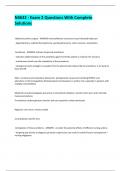N3632 - Exam 2 Questions With Complete
Solutions
.Ablative/curative surgery - ANSWER-remove/destroy cancerous tissue/ diseased body part
- Appendectomy, subtotal thyroidectomy, partial gastrectomy, colon resection, amputation
.Anesthesia - ANSWER-3 phases of general anesthesia:
- induction (administration of the anesthetic agent→until the patient is ready for the incision),
- maintenance (until near the completion of the procedure)
- emergence (starts pt begins to awaken from the altered state induced by the anesthesia → pt ready to
leave the OR
Risks: circulatory and respiratory depression, postoperative nausea and vomiting (PONV), and
alterations in thermoregulation (Postoperative bronchospasm is another risk, especially in patients with
multiple comorbidities)
Moderate sensation/analgesia (conscious or procedural sedation): used for short-term and minimally
invasive procedures
Pt maintains cardiorespiratory function and can respond to verbal commands
Regional: near nerve, remains awake
Local (topical): specific area
.Anticipation of future problems - ANSWER-- consider the potential effects of different nursing actions
- Assigning low priority to diagnosis pt wants to ignore but can result in harmful future consequences =
nursing negligence
,.artificial airway - ANSWER-oropharyngeal: measure (mouth -> jaw), semi-folwer, curved tip up toward
mouth roof, auscultate = verify placement, remain on side, remove Q4H
nasopharyngeal (nasal trumpet): goggle/face shield, measure (nose tip -> ear lobe), semi-fowler
(unconscious = side-lie), insert nostril (resistance = stop -> try other nare), close mouth -> check tube
airflow = verify, remove Q8H
endotracheal: insert nose/mouth w/ laryngoscope = can't talk = use alternative methods/nonverbal
signs
traceostomy = can't speak, ineffective cough/ secretions = suction (may need analsthesia)
- change collar = 2nd person hold tube
.Assess children - ANSWER-- Wong-baker faces
- oucher pain scale (0-100 w/ pics) => older kids
- CRIES => 0-6 mth old
- COMFORT => critically ill = lvl of analgesia needed
- FLACC: face, legs, activity, cry, consolability => 2mth - 7yr unable to validate presence/severity
.Assess cog impair - ANSWER-- Facial expressions
- Verbalizations and vocalizations
- Body movements
- Changes in interpersonal interactions
- Changes in activity patterns or routines
- Changes in mental status, such as agitation and aggression
- pain hx, fam/caregiver observations
- Pain Assessment in Advanced Dementia (PAINAD): breathing, vocalization, facial expression, body
language, and consolability
.Assess older adult - ANSWER-Numeric Rating Scale = most common
,Wong-Baker FACES
Faces Pain Scale-Revised (FPS-R)
Iowa Pain Thermometer (IPT)
.back massage - ANSWER-calm enviro -> assess pain -> raise bed -> prone/side-lie -> assess skin -> warm
lube/lotion -> avoid injuries/IVs -> light gliding stroke (effleurage) -> grasp/compress morion (petrissage)
-> long stokes -> reassess pain -> doc time length/response
use pillows/side rails if pt unable to reposition
note ulcer/reddened area = don't massage -> reposition -> turning schedule
sepsis; fever over 100°F, sickle cell or HIV crisis = only hand/feet/scalp
older = less pressure/time, supine/sit
.Barriers to healthcare - ANSWER-Poverty: despair/resignation/fatalism, "Day-to-day" attitude, no hope
for the future, Unemployment, need for financial/government aid, unstable family structure, ↓self-
respect/community involvement (higher rates/risk of IV infection, decline in physical/mental health, TB)
DFW poverty = highest # city below poverty line in america
isolation, language or communication difficulties, seasonal occupations, migration patterns,
depersonalization, and institutional prejudice
.BETTER model - ANSWER-oncology pt
- Bring up topic of sexuality
- Explain concern with all aspects of pt's lives affected by dz
- Tell pt's sexual dysfunction can happen and you will address their concerns
, - Timing (important to address sexuality with each visit)
- Educate patients on SE of Tx / SE may be temporary
- Record assessment and interventions in pt's medical records
.Blended competencies: 1) Cognitive - ANSWER-Critical thinking: clear, precise, specific, accurate,
relevant, plausible, consistent, logical, deep, broad, complete, significant, adequate, and fair
Thinking purpose: identify goal → plan intervention
Knowledge adequacy: accurate, complete, factual, timely, relevant, what's at stake, how much time,
room for error?
Potential probs: untested/faulty assumptions, accepting an unproven claim or line of argument, bias
influencing thinking, reasoning illogically, generalizations
Helpful resources: recognize limits → seek help = clinicians, texts and journals, institutional policies and
procedures, and professional groups and writings
judgment/decision critique: identify alternatives → weigh consequences/merits → conclusion
.Blended competencies: 2) Technical - ANSWER-admin meds, assessment skills, inserting catheter
Practice, be familiar w/ equipment, learn from experts, ask for help
.Blended competencies: 3) interpersonal (interaction) - ANSWER-dignity/respect
- You are a person of worth, and I care about you
Caring relationship
- use opportunities for convo = leading questions




